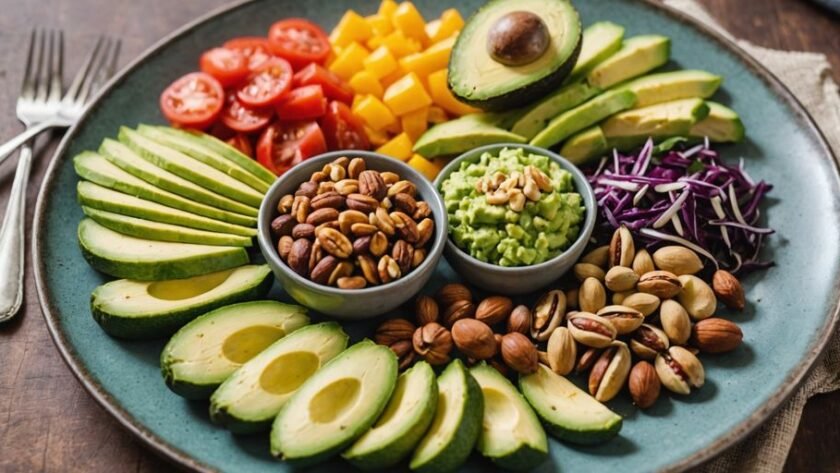Table of Contents
Combining a vegetarian lifestyle with a keto diet can be a fantastic way to boost your health and energy. This guide will help you understand the basics of a vegetarian keto diet, including what foods to eat and how to plan your meals. Plus, you’ll get tips on staying motivated and delicious recipes to try.
Key Takeaways
- A vegetarian keto diet combines low-carb eating with plant-based foods to promote weight loss and overall health.
- Essential foods include low-carb vegetables, healthy fats, and plant-based proteins like tofu and tempeh.
- Planning your meals ahead of time can help you stay on track and meet your nutritional needs.
- It’s important to consider micronutrient needs and possibly supplement to avoid deficiencies.
- Finding support through communities or tracking progress can keep you motivated on your diet journey.
Understanding the Vegetarian Keto Diet
Principles of Keto
The vegetarian keto diet plan combines the low-carb, high-fat principles of keto with a plant-based approach. This means you avoid meat and get your fats from plant sources like nuts, seeds, avocados, and oils. The goal is to enter a state called ketosis, where your body burns fat for energy instead of carbs.
Benefits of a Vegetarian Approach
A keto diet for vegetarians offers several benefits. You can lose weight, improve blood sugar levels, and boost your energy. Plus, it aligns with ethical and environmental values. By focusing on plant-based fats and proteins, you can enjoy a healthier lifestyle.
Common Misconceptions
There are some common misconceptions about the vegetarian keto diet. Some people think it’s hard to get enough protein or that it’s too restrictive. However, with the right planning, you can meet your nutritional needs and enjoy a variety of delicious meals.
Adopting a vegetarian keto diet can be a rewarding journey, offering both health benefits and alignment with ethical values.
Essential Foods for a Vegetarian Keto Diet

Low-Carb Vegetables
Low-carb vegetables are the backbone of your vegetarian keto diet. They provide essential vitamins and minerals while keeping your carb intake low. Here are some top choices:
- Spinach: Multipurpose, nutrient-dense leafy green
- Kale: High in vitamins and fiber
- Cauliflower: Great for making keto-friendly rice, mashed potatoes, and other dishes
- Broccoli: Rich in fiber and low in carbohydrates
- Green Beans: This low-carb veggie can be utilized in various recipes
- Asparagus: A vegetable high in vitamins and minerals
Healthy Fats
Healthy fats are crucial for maintaining ketosis. They provide energy and help you feel full. Include these in your diet:
- Ghee: A type of clarified butter
- Coconut Oil: High in healthful fats
- Avocado Oil: A multipurpose oil with a mild taste
- Olive Oil: Excellent for salad dressings and sautéing
Protein Sources
Getting enough protein is essential, even on a vegetarian keto diet. Here are some great options:
- Paneer (Indian Cottage Cheese): A protein and fat-rich mainstay
- Tofu: Soy protein source
- Tempeh: Nutty-flavored fermented soy food
- Eggs: Source of protein and good fats
Remember, a well-rounded vegetarian keto diet includes a variety of low-carb vegetables, healthy fats, and protein sources to keep you energized and satisfied.
By focusing on these essential foods, you can create a balanced and nutritious vegetarian keto meal plan that supports your health and wellness goals.
Meal Planning Strategies

Creating Balanced Meals
When planning your meals, aim for a balance of low-carb vegetables, healthy fats, and protein sources. This ensures you get all the nutrients you need while staying within your carb limits. A typical meal might include a large salad with avocado, nuts, and a protein source like tofu or tempeh.
Snacking on Keto
Snacking can be tricky on a keto diet, but there are plenty of options. Some great choices include:
- Nuts and seeds
- Cheese and olives
- Veggie sticks with guacamole
These snacks are low in carbs and high in healthy fats, making them perfect for keeping you full between meals.
Batch Cooking Tips
Batch cooking can save you time and ensure you always have keto-friendly meals on hand. Here are some tips:
- Plan your meals for the week.
- Cook large batches of staples like roasted vegetables and tofu.
- Store meals in portion-sized containers for easy access.
Batch cooking not only saves time but also helps you stick to your diet by having ready-made meals available.
By incorporating these strategies, you can make your vegetarian keto journey smoother and more enjoyable.
Nutritional Considerations

Micronutrient Needs
When following a vegetarian keto diet, it’s crucial to monitor your intake of essential nutrients. Nutrient deficiencies can occur if you’re not careful. Key nutrients to watch include:
- Vitamin B12
- Iron
- Calcium
- Omega-3 fatty acids
- Vitamin D
Supplements to Consider
Given the restrictive nature of a vegetarian keto diet, you might need to consider supplements. These can help you meet your nutritional needs and avoid deficiencies. Common supplements include:
- Vitamin B12
- Vitamin D
- Iron
- Omega-3 fatty acids
- Calcium
Hydration and Electrolytes
Staying hydrated is essential, especially on a keto diet. You should also pay attention to your electrolyte levels. Important electrolytes include sodium, potassium, and magnesium. Drinking plenty of water and considering electrolyte supplements can help maintain balance.
Remember, while weight loss is important, your long-term goal should always be a healthy body.
Delicious Vegetarian Keto Recipes
Breakfast Ideas
Start your day with a variety of tasty breakfast options that are both vegetarian and keto-friendly. Here are some ideas to get you going:
- Veggie Keto Scramble
- Keto Banana Bread
- High-Protein Vegetarian Breakfast with Cheese, Eggs, and Spinach
- Coconut Chia Pudding with Cardamom and Saffron
Lunch and Dinner Options
For lunch and dinner, you can enjoy a range of delicious meals that fit perfectly into your vegetarian keto meal plan. Try these recipes:
- Cauliflower Mac and Cheese
- Keto Grilled Vegetable Chopped Salad with Avocado Dressing
- Keto Zucchini Pizza Boats with Goat Cheese
- Tofu Tikka Masala with a Side of Sautéed Spinach
Snack Recipes
Snacking on keto doesn’t have to be boring. Here are some quick and easy snack ideas to keep you satisfied throughout the day:
- Keto Seeded Crackers and Goat Cheese
- Keto Cheesecake Fat Bombs
- Sliced Cucumber or Radishes with Mint Chutney
- A Handful of Almonds or Walnuts
With these simple & easy Indian vegetarian keto recipes for breakfast, lunch, and dinner, you can achieve your weight loss goals and stay fit. Enjoy the journey of discovering new flavors and maintaining a healthy lifestyle!
Staying Motivated on Your Diet Journey
Setting Realistic Goals
Setting achievable goals is key to staying motivated. Start with small, manageable changes and gradually build up. For example, aim to reduce your carb intake slowly rather than all at once. This way, you won’t feel overwhelmed and are more likely to stick with the diet.
Tracking Progress
Keeping track of your progress can be incredibly motivating. Use a journal or an app to log your meals, exercise, and how you feel each day. This will help you see how far you’ve come and identify any areas that need adjustment.
Finding Supportive Communities
Joining a community of like-minded individuals can provide the support and encouragement you need. Look for online forums, social media groups, or local meetups where you can share your experiences, ask questions, and get advice.
Remember, the journey to a healthier you is a marathon, not a sprint. Stay patient and keep pushing forward.
Conclusion
In conclusion, embarking on a vegetarian keto diet can be a rewarding journey towards better health and vitality. By combining the principles of low-carb eating with the ethical and environmental benefits of vegetarianism, you can achieve your wellness goals without sacrificing taste or variety. Remember, the key to success lies in careful planning, understanding your nutritional needs, and being open to trying new recipes and ingredients. With the right resources and a bit of creativity, you can enjoy a diverse and satisfying diet that supports your health and aligns with your values. Download the free PDF meal plan to get started on your vegetarian keto journey today!
Additional-resources
FAQ
What is a vegetarian keto diet?
A vegetarian keto diet is a low-carb, high-fat eating plan that excludes meat. It focuses on plant-based protein sources and healthy fats while keeping carbohydrate intake very low.
What are the benefits of a vegetarian keto diet?
This diet can help with weight loss, better blood sugar control, improved mental clarity, and increased energy levels. It also supports ethical and environmental values linked to vegetarianism.
What are some good protein sources on a vegetarian keto diet?
Good protein sources include eggs, dairy products like cheese and yogurt, tofu, tempeh, and some nuts and seeds.
Can I eat fruits on a vegetarian keto diet?
Most fruits are high in carbs and should be limited. However, small portions of berries like strawberries, blueberries, and raspberries can be enjoyed occasionally.
How do I stay hydrated on a vegetarian keto diet?
Drink plenty of water and consider beverages like herbal teas. It’s also important to maintain electrolyte balance by consuming enough sodium, potassium, and magnesium.
Is a vegetarian keto diet suitable for everyone?
While many people can benefit from this diet, it’s not for everyone. Always consult with a healthcare professional before starting any new diet, especially if you have underlying health conditions.




